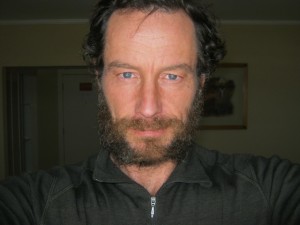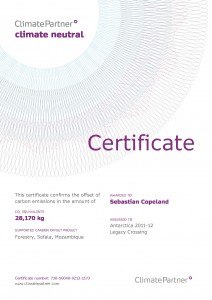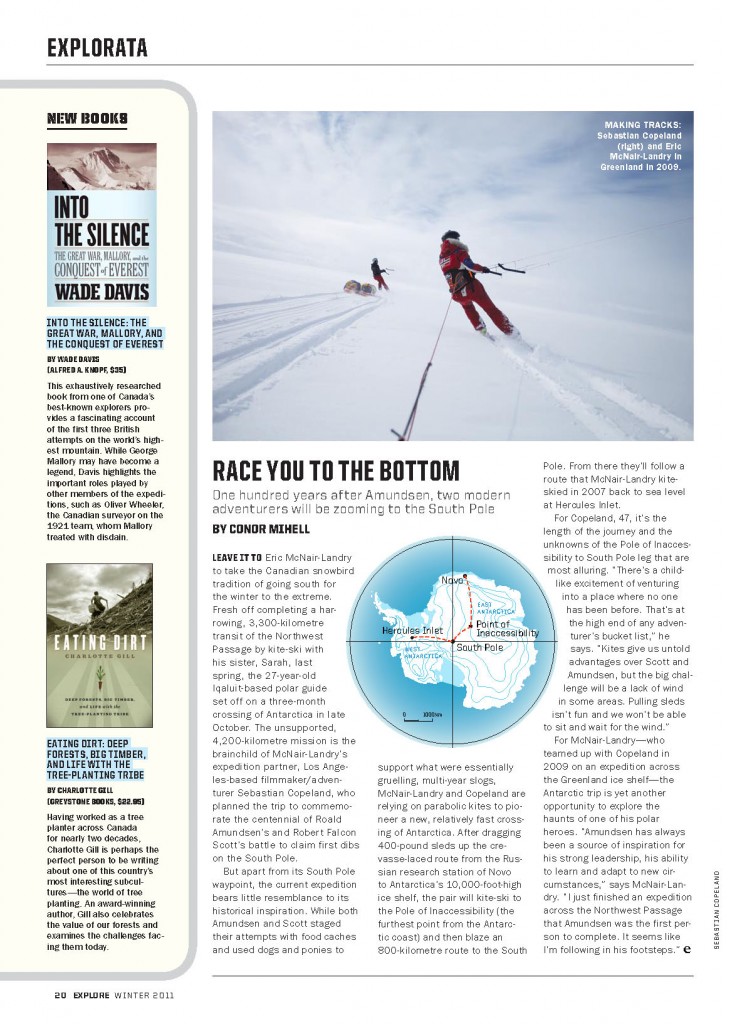February 1, 2012

The days spent here in Chile are all about rest, food, social re-acclimating, and the slow re-integration to communication and interaction with the world. The basic, if arduous, daily objective of simply moving forward on the ice and making miles is always refreshing in its simplicity. No clutter; no emails; no to-do lists. The limited and mostly one-way communication, dictated by the isolation and the self-defining nature of constant movement, go a long way to facilitate a deep cycle mind-altering calmness. In spite of all the challenges, aches and pains and eventual injuries, the peace this brings mostly defines the appeal of the exercise. Simplicity, in a complex world, is hard to come by! The extraction from that state is always jarring in the first few days. But with a slow thaw, I am coming back to face the music; and it doesn’t sound so bad!
Food has been a great, new companion in this recovery process. Eric is thin to begin with at about 160 pounds wet. His weight loss was in the order of twelve pounds. Mine has been more substantial: from 213 pounds, I came in at 183, or a net loss of thirty pounds. My body fat is presently between 7 and 8 percent: skin and bones! I have been wanting to work out to regain some strength in the atrophied areas. Many muscle groups don’t work while kiting and the body cannibalizes those areas, as well as fat, to generate warmth and energy in a cold environment. Consequently, while some areas like thighs, abdominals and upper back remain well developed, others such as chest, biceps, triceps, shoulders, lats and quad muscles go the way of the dodo. They will come back. Unfortunately, my sore toes, and the dressing that covers them, hinders a variety of exercise routines; so I will take a couple of weeks off—and eat. It is interesting to see the body filling up—it doesn’t waste anytime, particularly in re-storing fat reserves! Polar travel is the best weight loss program I have come across!
An expedition of this scope relies on broad people support, sponsors, factors, and benefactors. While the attention invariably centers on the lead actors, there are a host of financial, logistics and emotional players without whom the expedition could not proceed. I would like to take a moment to thank and acknowledge those.
First come my sponsors. Most have been lending me support for multiple years and have remained loyal to my efforts. It is hard to find ways that properly address the debt of gratitude that I hold for your faith in my endeavors. This is made all the more special as each one is top of class, and benchmark of quality. HP, whose corporate sustainability culture has made for an ideal partner, also lent technology to the trip: the iPack, now smart phone, is an invaluable and bombproof tool, and a staple of expedition communication, the world over. Thank you Karen Cage for your steadfast commitment to see this one through! Andrea, Alessandra and Martino and my friends at Napapijri: not only have you supported my endeavors since 2005, the designs and customized alterations have made for the best cold environment clothing that I know. They have kept us warm and stylish on the ice and I am proud to be your ambassador. Julie and REVO sunglasses: hands down the best polarized glass anywhere. I cannot think of an environment that is more exacting on eyewear than Antarctica. Thank you for meeting my specification for the frames while outfitting them with the best lenses on the market. Jason and the team at Rossignol: between Greenland and Antarctica, I have put over 6500 kilometers on one pair of skis over some of the most shredded, bone jarring ice anywhere! The fact that the sticks have held as well as they have is a testament to the company’s manufacturing excellence. You are the gold standard. I am proud to have kept my life in your hands. Matt and Ozone Kites: thank you for once again promoting the sport by supporting this expedition and allowing us to push the limits of polar travel. Ozone kites are the criterion by which all others are measured, and the very best kites in the world. Hilleberg tents have sheltered, cocooned and otherwise saved my life on multiple trip. ON this trip, the tent was also a friend and a beacon of warmth at the end of long, hard day. Thank you for being there, Petra, once again. The Herbalife powders and supplements have been a part of my expedition for four years now; I would not dream of leaving for the ice without them. Thank you Luigi for your ongoing support. I have relied on my trusty, bombproof Canon 5D Mark II’s to capture both photos and stunning 1080 HD video footage for the upcoming documentary chronicling the mission. The cameras have survived some of the harshest treatment imaginable; I don’t know how but they still hold up. On a kite skiing mission where peanuts turn to butter from the shake, this says a lot! Thank you Scott for your ongoing support. Thank you Jeff Cable and Lexar: your cards I have used from the North Pole to the South Pole, across many ice caps. They have never failed on me, in spite of the abuse. The best memory on the market. Climate Partner has once again made the trip carbon neutral. Thank you for your support and allowing me to put consequence behind my positions! For the first time this trip, we brought Organic Food Bars to supplement our lunches. I would not leave on a trip without them from now on: organic and sometimes even vegan, the bar’s cooking process prevents them from freezing even in 50C below, all the while delivering over 300 healthy calories. Cold Avenger masks provided facial warmth for the colder days, and prevented sucking on cold air all day long.Finally, there are all my friends at Global Green whose tireless work on climate change inspires me to be better: thank you!
I also want to thank all of the supporters who put their money where their mouths are to endorse our kickstarter efforts leading into this expedition. Your help was invaluable; your generosity crucial. Just as important are all of you who kept up with the expedition, left comments on my website, shared the information on FaceBook or followed us an re-posted on Twitter. Knowing from the ice that so many remained faithful to the daily updates was a huge factor in motivating me to share more insight into our experience. You provided an audience to our unfolding play, and gave us wings to fly to the finish line. Thank you!
Of critical importance to the success of the mission, were the logisitics teams overseeing our SAR (search&rescue), providing medical advice and with whom I communicated daily. I want to thank Victor Serov of TAC for being such a gentleman in Cape Town, as well as Andrey and Mikhail who provided daily support form Novolazarevskaya until we reached the South Pole. From the South Pole on, the folks at ALE never failed to deliver encouragement and enthusiasm for our mission. Thank you Marc de Keyser for once again lending your eye into the future: your spot on weather predictions helped appease our spirits when it was needed. The scope of ALE’s logistics expertise is hard to describe: it has to be seen to be believed. Mike, Steve, Peter and the whole crew at ALE: bravo!
I want to acknowledge Jessica, my assistant, who from behind the scenes, made sure that all updates were posted, while every other detail was overseen smoothly during a three and a half months absence. Jess, you were the pillar that held the house. Thank you.
I want to thank Eric, my partner on one more expedition. Your calm under pressure, kiting expertise, and deft, MacGyver skills make you an invaluable asset on any mission. While your right boot, lent without hesitation to protect my frostbitten toe, single handedly saved our mission!
Finally, I want to thank my soul mate and life partner. You are my rock and the angel that sits on my shoulder. Your patience is the currency that kept my spirits up, and had me smiling through the tough times. Four months of absence is a high price to ask of anyone. Yours was the greatest of sacrifices. I cannot wait to thank you for the rest of our lives.
Oh, and I almost forgot: she said yes!
*Photo Caption: Chilling in Chile, in search of a good barber!
More





